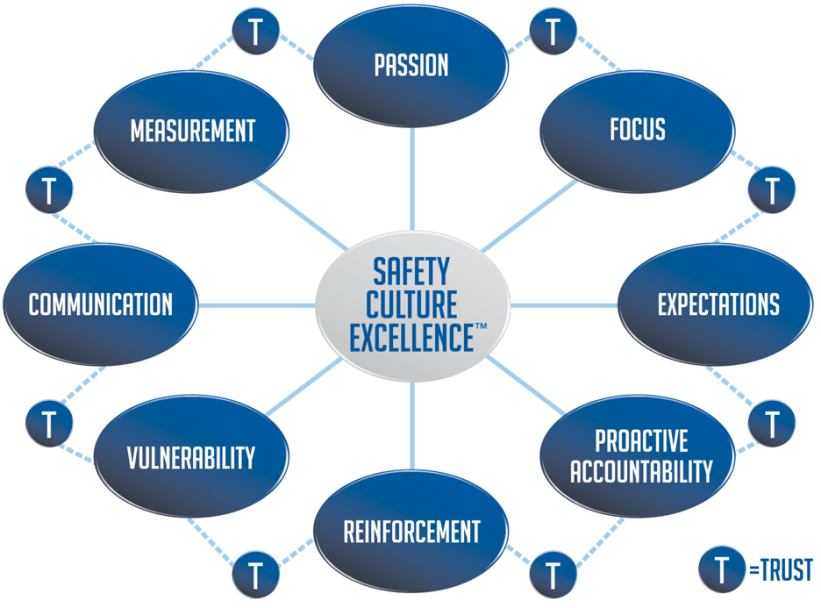Occupational Health & Safety - July 2014
By: Shawn M. Galloway
Printable Version
Regardless of safety maturity, your safety culture goal should be to evolve, not create. Beliefs already exist. Behaviors are currently observable. The way we do things around here, why we do what we do, what is rewarded and what it takes to get ahead are all quickly apparent to individuals joining the rank and file. Unless you are starting a new company, bringing people together for the first time, your cultural focus on safety already exists, good, bad or indifferent. Now, how to improve it?
Rather than attempt to benchmark against other cultures, which is often more demotivational than helpful, work to better understand the current reality and what has created it. Individually, or as a group, discuss your answers to the following ten questions.
- What percent of the population is passionate about safety excellence and the effort it will take to achieve it?
- What is the clear and concise focus for continued improvement in safety, and is everyone aligned on what it will take to further improve?
- Is everyone aware of what is expected of them, individually, to continuously improve injury-prevention efforts and advance the safety culture?
- How well are we proactively holding people accountable for the behavior and performance we expect of them (not just the results), and how positive is this perceived?
- Are we confident the right things are reinforced in the absence of leaders? Are the focus and expectations reinforced culturally when no one is looking?
- Are we maintaining a healthy degree of fear and a sense of organizational and individual vulnerability in safety?
- Is communication in safety boundaryless, free-flowing and unfiltered, and are the right messages sent, received and understood in any direction?
- Are our safety measurements motivating, prompting, and aligning behavior? Are the right things being measured and providing insight into results, how they were achieved and can be repeated?
- Do we have an organization where everyone trusts one another (e.g., peers, their boss, their direct reports, colleagues in another department) and we don't assume hidden agendas or malicious motivation?
- Have we created the necessary capabilities which enable continuous improvement in safety performance, and created a chemistry and climate in which such improvement is nurtured and encouraged?
In consulting with many of the best in safety performance and culture, nine elements have been identified as most important foci to establish the chemistry which facilitates the necessary climate for a culture of safety excellence to grow. As emphasized in the previous questions, these are: Passion, Focus, Expectations, Proactive Accountability, Reinforcement, Vulnerability, Communication, Measurement, and Trust. We at ProAct Safety call this The Chemistry of Safety Culture Excellencesm.

Figure one: The Chemistry of Safety Culture Excellence
Through consulting engagements and workshops, these nine elements have been successfully measured to help the organizations identify both their starting point baseline, and also to strategically prioritize which capabilities to focus on to advance the capabilities of their safety culture.
A simple exercise to measure your cultural maturity is to lead a group discussion (e.g., leadership team, safety committee, representation from the many levels and departments) on these nine elements to determine the average perceived scores (1-10) for these elements and understand what would have to be addressed to enhance them. These very insightful conversations identify the precise actions that need to be taken and ultimately leads to the creation of a 3-5 year strategic framework, prioritizing what and how to improve the safety aspect of the company culture.
Cultures will always influence the beliefs and behaviors of employees and contractors as they join the group. You can either manage the chemistry, climate and culture, or the results in any area of operational performance will be managed by them. To obtain a copy of a framework to lead the dialogue within your organization on these elements, please contact the author at info@proactsafety.com.
References:
Figure 1: Mathis, Terry & Galloway, Shawn, 2013, STEPS to Safety Culture Excellence, John Wiley & Sons Inc. (p. 76)

Shawn Galloway, CEO of ProAct Safety, is an expert in safety excellence. With almost thirty years of experience, he is a highly sought-after advisor, keynote speaker, and expert witness. Shawn has become a trusted partner to leading organizations across various industries worldwide. He ranks in the top 1% of the most prolific writers in his field, having authored over 500 articles and several bestselling books. He also launched the world's first safety podcast, Safety Culture Excellence©. As a recognized authority in safety, Shawn has received awards such as being named among the Top 50 People Who Most Influence EHS and a Top 10 Speaker, among others.
He is a regular guest on Bloomberg, Fox News, The Daily Mail, Dubai One, U.S. News & World Report, Sirius Business Radio, Wharton Business Daily, and leading safety magazines and podcasts. Shawn also serves as a member of the Harvard Business Review Advisory Council, Forbes Business Council, and Fast Company Executive Board, enabling his influence to shape safety thinking and strategy at the executive level.
